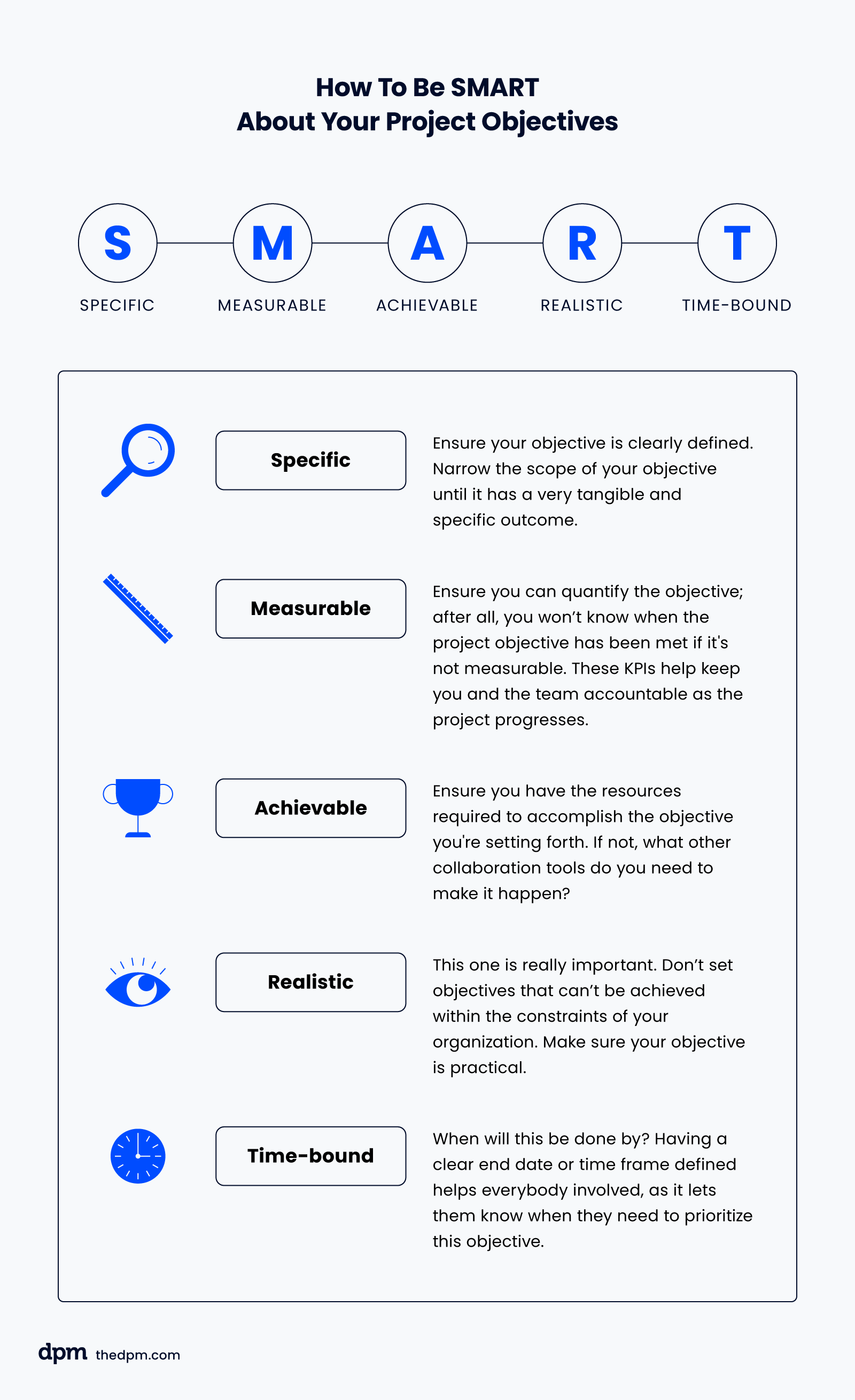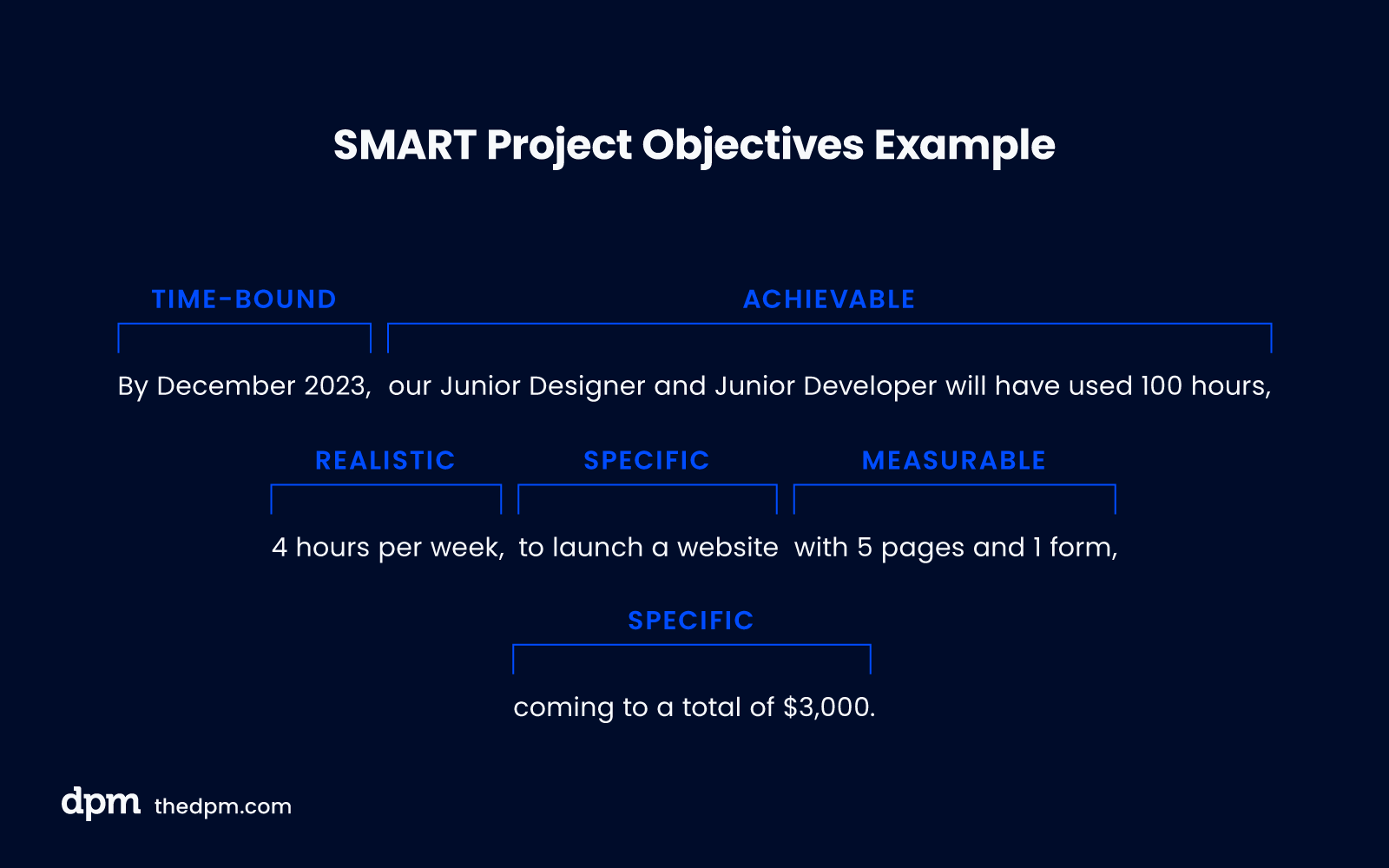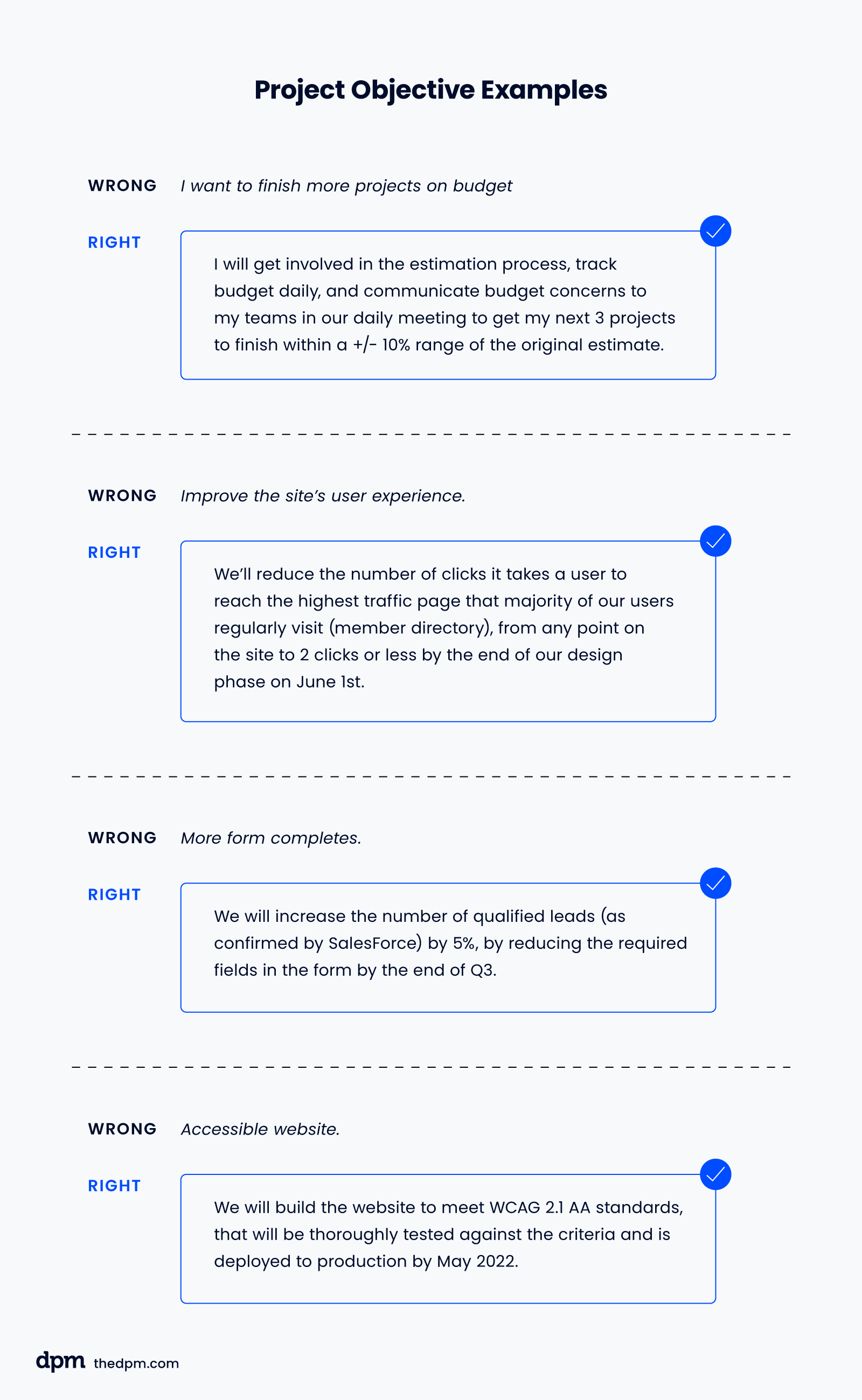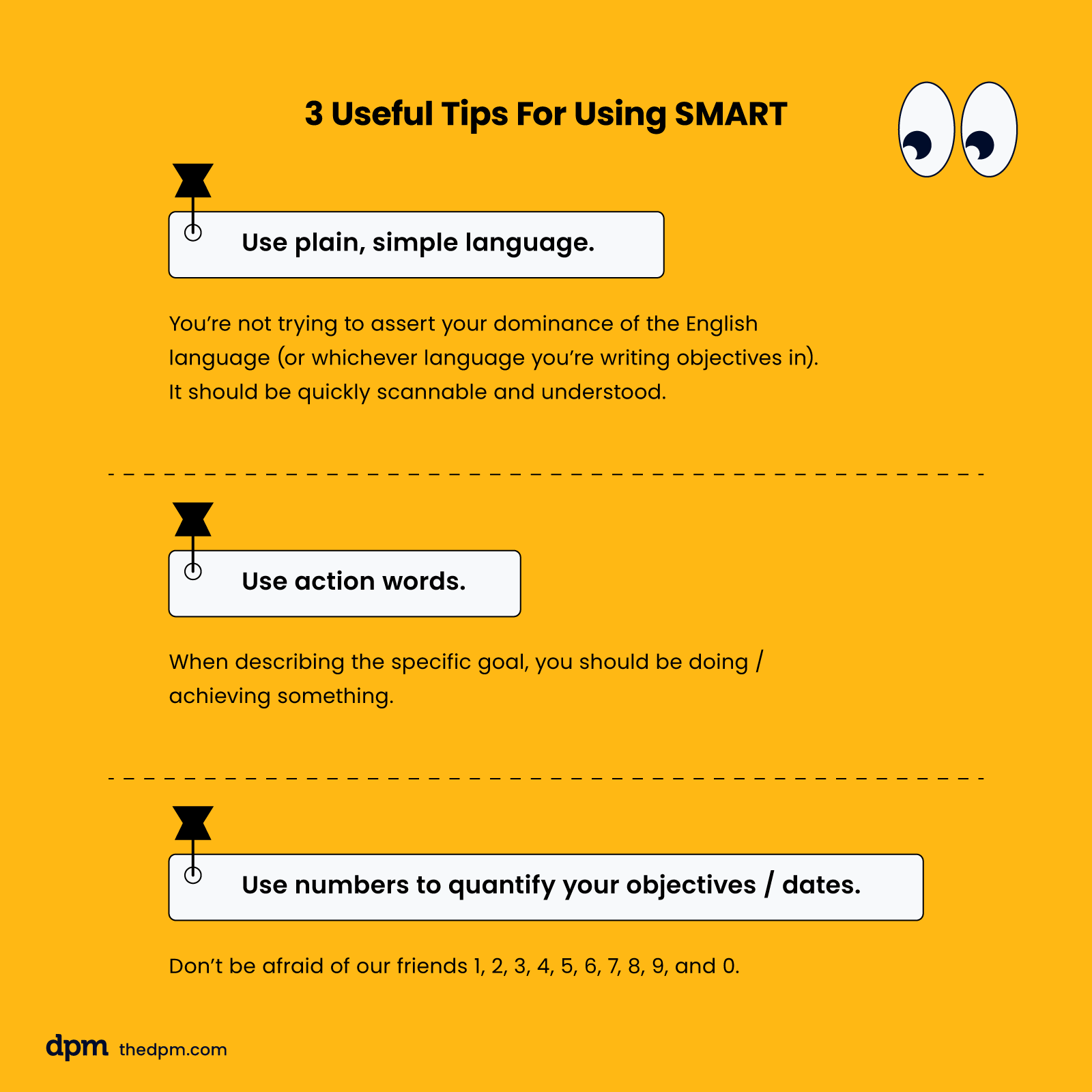Let's say your organization wants to increase sales by 25% and decides the best way to get there is by releasing a new product. As the project manager, you're in charge of the project objective. That is, releasing a new product.
Did you think the objective was to increase sales by 25%?
You wouldn't be alone.
What Are Project Objectives?
Project objectives are the concrete, practical, measurable tasks you need to complete in order to achieve your business goals. They're how you get the end result you're after, not the end result itself.
In the example from above:
- The project goal is to increase sales by 25%.
- The project objective is to design and release a new product.
Project objectives are achievable, realistic, within your direct control, and can be completed in the time you have allotted.
Project goals are the long-term outcomes you're hoping to achieve by undertaking the project in the first place. The two terms are commonly conflated because project goals often describe business objectives.
Here's a quick overview of this topic:
It’s worth using project management software or other work management tools to track objectives against your project plan and any project milestones.
Why Are Project Objectives Important?
Project objectives are important because they:
- Describe the how of what you're doing
- Communicate deliverables clearly, from the project's initiation to its end
- Guide the decisions made throughout a project's lifespan
- Ensure alignment by allowing project stakeholders to swiftly review, critique, and sign off on project methodology
- Help CYA (cover your ass) when the client decides to pivot on you
Effective project objectives are your directions; follow them and you'll find your way to the destination.
How to Write SMART Project Objectives
The key to a great project objective is clarity; the best way to achieve it is with the SMART framework, an acronym that stands for:
- S = Specific: Ensure your objective is clearly defined. Narrow the scope of your objective until it has a very tangible and specific outcome. Consider what project deliverables you'll need to maximize your chances of reaching the objective.
- M = Measurable: Ensure you can quantify the objective; after all, you won’t know when the project objective has been met if it's not measurable. These KPIs help keep you and the team accountable as the project progresses.
- A = Achievable (or attainable, actionable, appropriate): Ensure you have the resources required to accomplish the objective. If not, what other collaboration tools do you need? This ensures you have the appropriate resourcing to give your team a fighting chance of accomplishing it.
- R = Relevant: Ensure the objective is aligned with the business goals and long-term goals of the project and your organization as a whole.
- T = Time-bound (or timely, traceable): Having a clear end date or time frame defined everybody knows when they need to prioritize this objective. It also helps you see if you're on track for overall project completion.

Examples of SMART Objectives

Here's an example of an objective statement built using the SMART framework:
By December 2024, our Jr. Designer and Jr. Developer will have used their 4 extra hours per week to launch a website with 5 pages and 1 form, coming to a total of $3,000.
- Specific: I will launch a website for $3,000.
- Measurable: The website will have 5 pages and 1 form.
- Achievable: I can allocate 100 hours for a Jr. Designer and Jr. Developer at a blended rate of $30/hour while staying within budget.
- Relevant: The website will help us achieve our larger goal of increased lead generation.
- Time-bound: By December 2024
More SMART Project Objectives Examples
Here are a few more examples to hammer the point home.

- Instead of: I want to finish more projects on budget.
- Try: I will get involved in the estimation workflow, track budget daily, and communicate budget concerns to my teams in our daily meeting to finish my next 3 projects within a +/- 10% range of the original estimate.
- Instead of: Improve the site’s user experience.
- Try: We will reduce the number of clicks it takes for a user to reach the highest traffic page that the majority of our website users regularly visit (the member directory) from any point on the site to 2 clicks or less by the end of our design phase on March 1st.
- Instead of: More form completes.
- Try: We will increase the number of qualified leads (as confirmed by Salesforce) by 5% by reducing the required fields in the form by the end of Q2.
- Instead of: Accessible website.
- Try: We will build the website to meet WCAG 2.1 AA standards, which will be thoroughly tested against the criteria and deployed to production by May 2024.
- Instead of: I want a good review this year
- Try: By March 2024 I want to increase my annual review score from a 3 to a 4 by completing one course (like the DPM school 👀), reading one book, and committing to spend on average 1 hour a week on professional growth.
Tips For Writing SMART Project Objectives

Here are my top tips for writing project objectives:
- Use plain, simple language. You’re not trying to assert your dominance of the English language (or whichever language you’re writing your objectives in). It should be quickly scannable and understood.
- Use action words when describing the specific SMART goals. You should be doing or achieving something.
- Use numbers to quantify your objectives and dates. Don’t be afraid of our friends 123456789 and 0.
How Project Objectives Ladder Up Into The Project Plan
Project objectives describe what you’ll achieve within your project, and the project plan describes how you’ll get there.
Think of Simon Sinek's concept of The Golden Circle: Project goals are the why, project objectives are the how, and project plans are the what.
For example, consider the following projects:
- A new website build project that aims to increase overall organic search traffic for the company by 25%. The objective is to build a website.
- A customer acquisition project that aims to increase lead generation by 10% by providing free online templates. The objective is to create and release templates.
By zeroing in on the objectives, you can figure out what components you'll need.
For the former, you’d need developers, content strategists, SEO specialists, designers, and more. For the latter, you might simply need a few copywriters and subject matter specialists.
How To Identify The Right Project Objectives
While having clear project objectives is important, having the right project management objectives is the true key to project success.
If your internal dialogue goes something like this, you’re doing it right:
- Do I really want to increase page views by 20%? Or is it more valuable to increase quality leads by 5%?
- Is time on the page important? Or does that mean our users can’t find what they’re looking for?
Notice how, in each example, you’re questioning what you’re measuring rather than blindly assigning importance to metrics.
Validating Your Project Objectives
Let's expand on the first example I used above, highlighting questions you can ask to find the right project objectives:
- Increasing page views by 20%
- Is that more valuable than an increase in quality leads by 5%?
- Are page views important if bounce rates are high?
- Should we be looking to decrease bounce rates instead?
Onwards And Upwards!
Join in the conversation and share your best practices for project objectives by joining DPM membership. You'll get access to our Slack community, where you can network and discuss what 100s of other digital project managers.



